How Post-Harvest Irrigation Affects Almond Yield
Did you know that post-harvest almond irrigation is one of the most important water applications of the year that can drastically affect your next season’s yields?
Research has shown that depending on your pre-harvest irrigation practises, depriving your trees of post-harvest irrigation can significantly reduce next season’s fruit load anywhere from 41% to 77%.
In this post, we’ll provide an overview of the impacts of post-harvest irrigation on the development of next year's crop and the recommended actions to take post-harvest.
- What are the impacts of post-harvest irrigation on your bottom line?
- Why does post-harvest irrigation affect almond tree health and development?
- What does this all mean for almond growers?
- Summary
- Talk to an irrigation expert
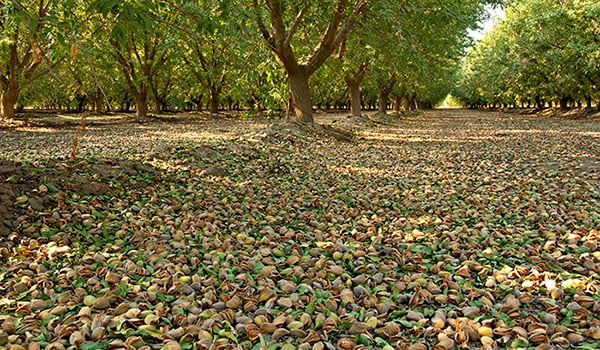
Harvest time at an almond orchard
What are the impacts of post-harvest irrigation on your bottom line?
Water is often a scarce and expensive resource for Australian almond growers, but it’s important to properly allocate water for post-harvest irrigation since it can greatly affect your bottom line the following year.
In a study from 2000, researchers Goldhamer & Viveros set out to investigate the effects of pre-harvest and post-harvest water deprivation on almond trees. They ran trials in northern Kern County, California, on nonpareil trees based on eight different pre-harvest irrigation cutoff regimes, with cutoff dates ranging from 8 to 57 days before harvest. After harvest, some trees were given post-harvest irrigation while the others had no post-harvest irrigation applied.
What they found was that post-harvest water deficits had a bigger impact on yield than water deficits pre-harvest.
By skipping post-harvest irrigation, trees had much lower yields the following season due to significant reductions in:
- kernel yield,
- bloom density,
- fruit set, and,
- fruit load.
In the graph below, you can see the reductions in the following year’s kernel yield based on the three shortest pre-harvest irrigation cutoff times that the researchers observed:
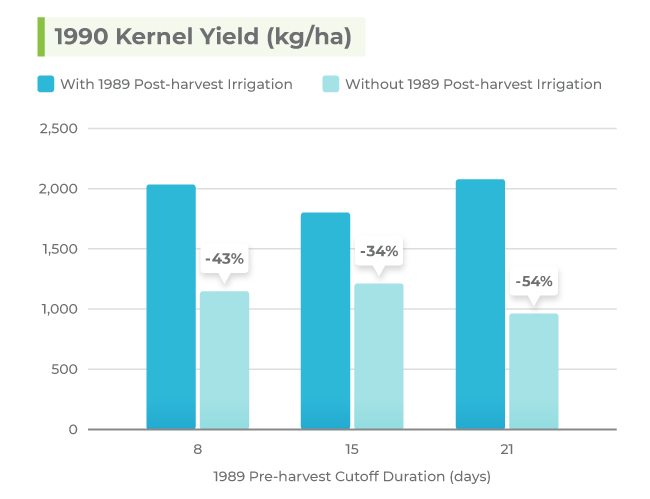
Researchers saw a reduction in kernel yield ranging from 43% to 54% in the trees that were not given post-harvest irrigation across the 8, 15, and 21-day pre-harvest irrigation cutoff regimes.
Why does post-harvest irrigation affect almond tree health and development?
A late bud differentiation
The months of February through to April signal both a busy time for almond growers and their trees. While growers have their hands full managing this year’s harvest, the development of almond trees towards next season’s yields is already underway.
During this time of the year, almond trees are experiencing bud differentiation. This is the process where vegetative buds transition into floral buds, which are responsible for fruit production. Compared to other tree crops, such as pistachios that can handle severe post-harvest water deficits without significant impacts, this is not the case with almond trees due to its late bud differentiation.
Because harvest and bud differentiation is around the same time for almonds, the trees are particularly sensitive to the impacts of post-harvest water deficits.
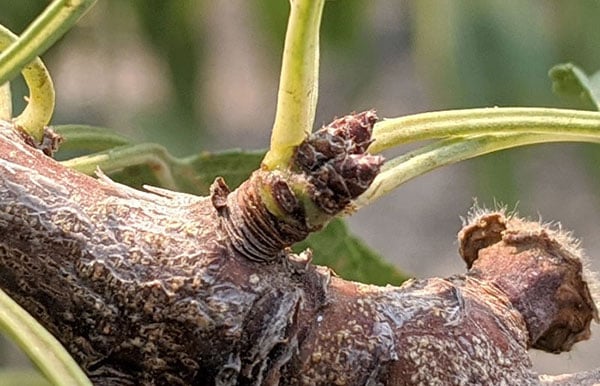
Dormant buds on an almond tree
Impacts of water stress
With the common practise of irrigation cutoff at hull split, the soil water content is already largely depleted post-harvest. In combination with the autumn rains not arriving until late April, Australian almond orchards are prone to experiencing prolonged water stress if no post-harvest irrigation is applied.
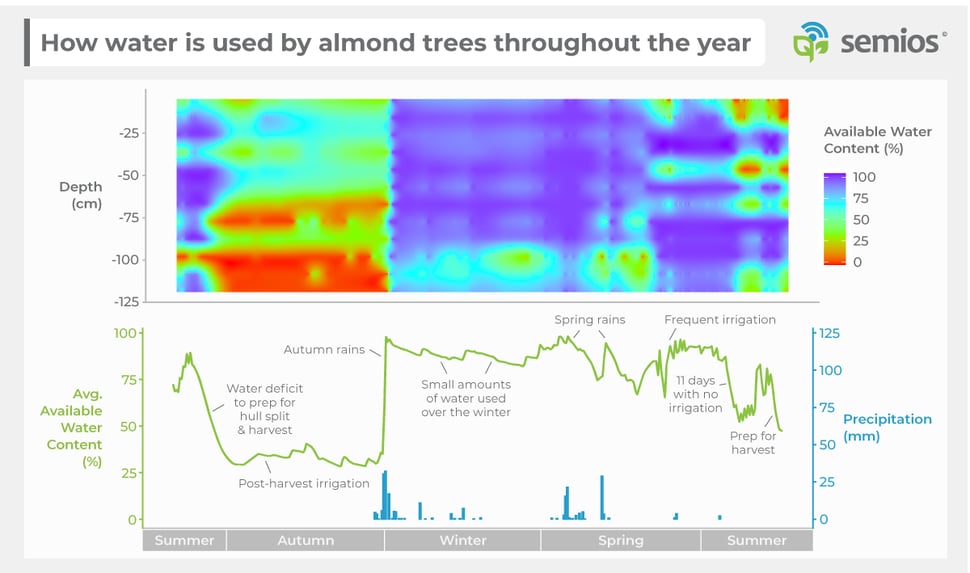
In this graph, you can clearly see the soil water content being depleted in the summer months leading up to harvest. Following harvest, there was some irrigation applied on several occasions to keep the leaves alive until the soil profile got replenished by rainfall. (Data collected by Semios soil moisture probes.)
The impacts of water stress post-harvest include poorer bloom development and fruit set the following year due to:
When trees are not fully defoliated, leaves can play an important role in the assimilation of carbon and mineral nutrients, and in sustaining root growth. Later, when leaves enter senescence, some of these nutrients are transported into the fruiting spurs.
Since almond trees already have reduced canopies from the irrigation cutoff and shaking process during harvest, it becomes critical to irrigate post-harvest to prevent further premature defoliation caused by water stress.
Soil Salinity in Almonds Post-Harvest
In areas where salinity is an issue, either from native salts in the soil or from irrigation water high in salts, post-harvest irrigation can be used for leaching.
During harvest, irrigations are reduced, leaving the soil depleted. This is why it is important immediately after harvest to begin filling your soil profile with a little bit more water than what is needed in preparation for leaching. The idea here is to reach field capacity around late May or early June, to prepare for winter leaching irrigation that will push those salts downward and outward.
If your soil is depleted during these events, the salts will move from wettest to driest and back into the active root zone. In summary, you want to fill your profile with water in preparation for winter leaching irrigation to push salts downward and outward from the active root zone.
💡 Tip: Semios users can use the Semios Salt Map to view salt concentration at each depth in the soil, helping guide their leaching practises.
What does this all mean for almond growers?
It’s clear that the impacts of neglecting post-harvest irrigation are significant for next year’s harvest.
The good news for growers who have a tight water budget is that the trees don’t need that much water post-harvest. Not only do almond trees have fewer leaves after harvest, but they also no longer have nuts that demand a constant supply of carbohydrates. This means that the trees are capable of reducing their water use.
The goal is to irrigate enough post-harvest to keep the leaves alive until the fall rains come.
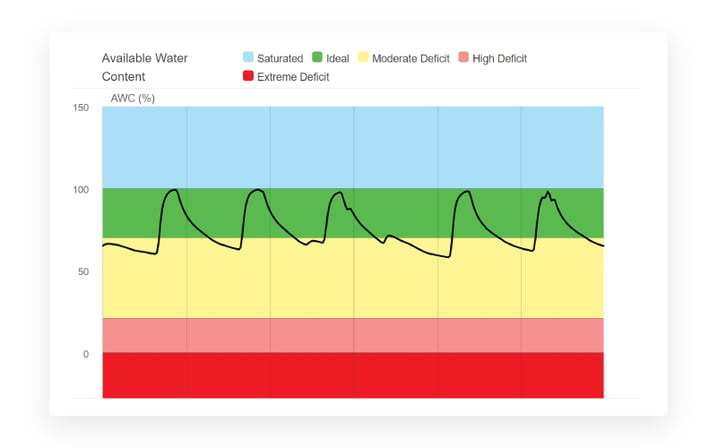
💡 Tip: Growers can use Semios' Soil Moisture Monitoring (part of Semios’ Water Management Tools & Crop Management Platform) shown above to quickly assess the available water content (AWC) at various soil depths in the field, and see how their irrigation applications are changing the AWC.
You will need to put enough water in the soil post-harvest to prevent leaves from yellowing and dropping off. It is important to maintain this level of available water content in your soil until the soil profile gets refilled by rainfall later in the year. While moderate water stress is acceptable during this period, you want to avoid severe stress so you don’t compromise next year’s yields.
Summary
Trees focus all of their efforts on producing a crop up until harvest. Post-harvest is the period where the trees can “rest up” by focusing on producing sugars and building up important nutritional minerals such as N-P-K that can be stored through the winter.
If the trees remain stressed and under-irrigated even after harvest is complete, they cannot effectively create and store sugars and accumulate nutrition. All of that nutrition and sugar is what the tree will rely on to bloom, grow out leaves, and set fruit in the spring. After the initial post-harvest irrigation, soil moisture sensors can be used to judge when additional water is needed. Care and preparation today will bring yields in the year to come.
Talk to an irrigation expert
With the current water challenges, using the right precision irrigation tools can help take the guesswork out of your irrigation practises so you can make the most of every drop.
Growers and their teams use the Semios all-in-one crop management platform to help them:
- Optimise water use with soil moisture content and plant stress monitoring,
- View where salts are located in the soil profile for salinity/fertiliser management,
- Save time with real-time, remote irrigation activity monitoring and control.
If you have any questions, leave a comment below or contact us directly to get connected with an irrigation expert.

